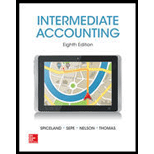
Concept explainers
A)
Lessee guaranteed residual value
The lessee guaranteed residual value of leased asset is an estimation of the commercial value of the asset at the end of lease term. The present value is considered when determining the lease classification criteria (Criteria 4). Lessee guaranteed residual value is added to lease receivable and also added to sales revenue.
To Determine: the amounts at the beginning of lease for the lessor at each independent situation.
A)
Explanation of Solution
| Situation | ||||
| 1 | 2 | 3 | 4 | |
| Lessor | ||||
| Minimum Lease payments | (1)400,000 | (2) 553,000 | (3) 640,000 | (4) 510,000 |
| Gross investment in the lease |
(5)430,000 | (6) 553,000 | (7) 675,000 | (8) 550,000 |
| Net investment in the lease |
(9)369,175 | (10) 433,809 | (11) 533,685 | (12) 451,137 |
| Sales revenue | (13)348,685 | (14)433,809 | (15) 512,816 | (16) 423,817 |
| Cost of goods sold | (17)348,685 | (18)449,896 | (19) 479,131 | (20) 372,680 |
| Dealers profit | (21) $0 | (22)$(16,087) | (23) $33,685 | (24) $51,137 |
Table (1)
Working note:
The lease payment is calculated as follows:
The gross investment in lease is calculated as follows:
The net investment in the lease is calculated as follows:
Sales revenue is calculated as follows:
Cost of goods sold is calculated as follows:
Dealers profit is calculated as follows:
(B)
the amounts at the beginning of lease for the lessee at each independent situation.
(B)
Explanation of Solution
| Situation | ||||
| 1 | 2 | 3 | 4 | |
| Lessee | ||||
| Lease payments | (25) 400,000 | (26) 553,000 | (27) 640,000 | (28) 460,000 |
| Leased asset | (29) 353,129 | (30) 449,896 | (31) 512,816 | (32) 389,666 |
| Lease payable | (29) 353,129 | (30) 449,896 | (31) 512,816 | (32) 389,666 |
Table (2)
The lease payment is calculated as follows:
The amount to be recorded as leased asset and lease liability is calculated as follows:
Note:
Present value of the minimum lease payments and leased asset is calculated based on the discounted rates at lower of lessor and lessee.
Want to see more full solutions like this?
Chapter 15 Solutions
INTERMEDIATE ACCOUNTING
- How much is net sales revenue?arrow_forwardA company, Taylor Manufacturing, sells a plant asset that originally cost $450,000 for $175,000 on June 30, 2023. The accumulated depreciation account had a balance of $210,000 after the current year's depreciation of $35,000 had been recorded. Taylor Manufacturing should recognize a____. (a) $175,000 gain on disposal (b) $65,000 loss on disposal (c) $65,000 gain on disposal (d) $35,000 loss on disposalarrow_forwardI am looking for the correct answer to this general accounting problem using valid accounting standards.arrow_forward
- Kindly help me with this General accounting questions not use chart gpt please fast given solutionarrow_forwardI need help finding the accurate solution to this general accounting problem with valid methods.arrow_forwardHow can I solve this financial accounting problem using the appropriate financial process?arrow_forward
- I need the correct answer to this general accounting problem using the standard accounting approach.arrow_forwardThe cost per equipment unit for materialsarrow_forwardThe owner's equity at the beginning of the period for Vortex Traders was $47,000. At the end of the period, assets totaled $120,000, and liabilities were $34,000. If the owner made an additional investment of $10,000 and withdrew $7,000 during the period, what is the net income or (net loss) for the period?arrow_forward
- Megan Apparel had annual revenues of $312,000 and expenses of $187,000, and the company paid dividends of $35,000 during the current year. The retained earnings account before closing had a balance of $420,000. What is the net income for the year?arrow_forwardB-Mart has a beginning receivables balance on July 1 of $1,780. Sales for July through October are $895, $1,240, $1,425, and $2,350, respectively. The accounts receivable period is 30 days. What is the amount of the September collections? Assume a year has 360 days.arrow_forwardPlease explain the solution to this general accounting problem with accurate explanations.arrow_forward

 AccountingAccountingISBN:9781337272094Author:WARREN, Carl S., Reeve, James M., Duchac, Jonathan E.Publisher:Cengage Learning,
AccountingAccountingISBN:9781337272094Author:WARREN, Carl S., Reeve, James M., Duchac, Jonathan E.Publisher:Cengage Learning, Accounting Information SystemsAccountingISBN:9781337619202Author:Hall, James A.Publisher:Cengage Learning,
Accounting Information SystemsAccountingISBN:9781337619202Author:Hall, James A.Publisher:Cengage Learning, Horngren's Cost Accounting: A Managerial Emphasis...AccountingISBN:9780134475585Author:Srikant M. Datar, Madhav V. RajanPublisher:PEARSON
Horngren's Cost Accounting: A Managerial Emphasis...AccountingISBN:9780134475585Author:Srikant M. Datar, Madhav V. RajanPublisher:PEARSON Intermediate AccountingAccountingISBN:9781259722660Author:J. David Spiceland, Mark W. Nelson, Wayne M ThomasPublisher:McGraw-Hill Education
Intermediate AccountingAccountingISBN:9781259722660Author:J. David Spiceland, Mark W. Nelson, Wayne M ThomasPublisher:McGraw-Hill Education Financial and Managerial AccountingAccountingISBN:9781259726705Author:John J Wild, Ken W. Shaw, Barbara Chiappetta Fundamental Accounting PrinciplesPublisher:McGraw-Hill Education
Financial and Managerial AccountingAccountingISBN:9781259726705Author:John J Wild, Ken W. Shaw, Barbara Chiappetta Fundamental Accounting PrinciplesPublisher:McGraw-Hill Education





